Lithium-Ion Battery Performance Factors
Dr. Qifeng Zhang, Mr. Evan Uchaker, Dr. Guozhong Cao
Department of Materials Science and Engineering University of Washington Seattle, WA 98195-2120
Section Overview
- Introduction
- MnO2 Nanowall Arrays
- TiO2 Nanotube Arrays
- V2O5 Xerogel Films
- Nanostructured V2O5
- LiFePO4/C Nanocomposites
- Conclusions and Remarks
- Related Products
- References
Introduction
Lithium-ion batteries represent a group of electrochemical devices used for electricity storage and have attracted a lot of attention in the past two decades due to their portability, rechargeability, and low cost. The major effort on lithium-ion batteries (LIBs) at present is to optimize the materials that form the cathode or anode films to increase the battery capacity to reach the theoretical maximum with enhanced cyclic stability in relation to lithium-ion intercalation and deintercalation. It has been proven that both the capacity and stability of LIBs are closely related to the materials being used to form the electrodes. More specifically, the battery capacity and stability greatly rely on chemical composition, microstructure, crystallinity, and defects of the electrode materials. This review features several materials involved in our work on LIBs. The performance of LIBs can be improved to a large extent by: (1) tailoring the microstructure; (2) controlling the crystallinity of electrode materials; and/or (3) introducing suitable defects to the materials, thereby enhancing the electron and mass transport to improve the battery stability.
MnO2 Nanowall Arrays
One of the most outstanding advantages of nanostructured materials is that they can form porous films that result in extremely high internal surface area. This is particularly important for electrochemical devices such as LIBs which involve a faradaic reaction at the solid/liquid interface formed by electrode film and liquid electrolyte. MnO2 is one of several commonly used LIB materials. However, MnO2 (Product. No. 529664) microsized particles prepared using conventional slurry methods to form electrode film demonstrate relatively low discharge capacities of ~120 mAh/g.1 MnO2 nanowall arrays are a novel nanostructure and reportedly achieve both a significantly higher discharge capacity and good cyclic stability due to their large surface area and short pathways for lithium-ion diffusion. The approximately amorphous phase structure of the nanowalls results from the cathodic electrodeposition method used to fabricate the electrode film.2
The MnO2 nanowall arrays were prepared using an electrodeposition method from a solution containing 0.1 M manganese acetate (Product. No. 330825) and sodium sulfate (Product. No. 793531) under a constant voltage ranging from –1.2 to 2.2 V for 15 min. The MnO2 nanowall arrays were grown on a platinum foil substrate at the cathodic side; a separate platinum foil was used in anode of the deposition system. The deposited film was washed with deionized water and then air-dried without any further treatment.
Figure 1 shows a typical SEM image of the as-prepared MnO2 nanowall array film. It reveals the porous structure of the electrode film is comprised of vertically grown MnO2 walls of 50–100 nm thickness. The film was also characterized using X-ray diffraction and found to be approximately amorphous, although the peaks presented a slight match with those of ε-MnO2.2 The thermogravimetric analysis revealed the as-produced nanowall arrays had a chemical composition of MnO2・nH2O with n≈0.5.
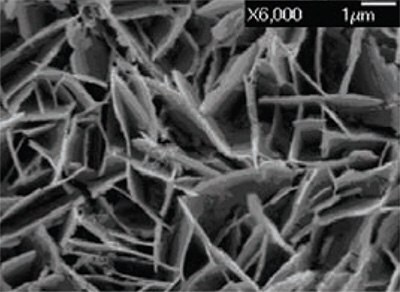
Figure 1.Morphology and structure of MnO2 nanowall arrays produced from cathodic electrodepostion.2
Formation of the nanowall structure is a result of water electrolysisinduced precipitation of MnO2 at the cathode side, where H2 gas bubbles generated due to water electrolysis play an important role in the formation of the porous nanowall structure.2,3 The height of the nanowalls is dependent on both the applied bias and the deposition time. For example, the use of –1.2 V for 15 min. led to ~500 nm high nanowalls, which increased to 2.5 μm with the applied bias of –1.8 V for 15 min. However, the increase in nanowall height didn’t result in an increase in the internal surface area of the electrode film due to an increase in the nanowall thickness. The nanowall thickness is also a function of the concentration of the solution. High concentration generally results in thick nanowalls and leads to low internal surface area.3
Electrochemical characterization of the MnO2 nanowall array revealed excellent charge/discharge properties in less crystallized nanowall structures. The nanowall array of ~2.5 μm height (i.e., film thickness) deposited at –1.8 V presented an initial discharge capacity of 270 mAh/g at a rate of 0.1 mA/cm2 (corresponding to a current density of 76 mA/g). The capacity remained as high as 220 mAh/g even over 50 cycles, which significantly exceeds the typical capacity of 120 mAh/g for a traditional MnO2 electrode. These results indicate MnO2 nanowall arrays are a promising material for lithium-ion intercalation/deintercalation due to both their high capacity and good stability,2 which are attributed to: (1) the large surface area of the porous nanowall structure; (2) short pathways for lithium-ion diffusion; and (3) the approximately amorphous structure of the nanowalls, making the electrode film less well packed and, therefore, possess a greater capacity for structural accommodation during lithium-ion intercalation/deintercalation.
TiO2 Nanotube Arrays
Annealing Temperature Effect
TiO2 nanotube arrays have generated significant interest for use in electrochemical and photoelectrochemical devices due to their ordered one-dimensional structure that possesses a large internal surface area and may provide direct pathways for ion and electron transport.4,5 The significant attention received by TiO2 nanotube arrays is also attributed to their ease of fabrication through a simple anodization method. The nanotube diameter, length, and wall thickness can be readily controlled by adjusting the recipe of electrolyte, applied voltage, and time for anodization. For LIB application, it has been found that in addition to the structural parameters such as nanotube diameter, length, and distribution density, both the capacity and the cyclic stability of an electrode film consisting of TiO2 nanotube arrays are also affected by the post-treatment parameters.6,7
Figure 2A shows a typical SEM image of TiO2 nanotube array produced using anodization with an electrolyte containing 0.1 M KF and 1.0 M NaHSO4, at a constant potential of 20 V, for 1 hr. The nanotubes are ~100 nm in diameter and 1.1 μm in length. The direct use of the as-deposited TiO2 nanotube array in a lithium-ion battery results in an initial discharge capacity of ~202 mAh/g, which degrades very quickly to 40 mAh/g after 50 cycles.7 The poor cyclic stability is attributed to the amorphous phase of the as-deposited TiO2 nanotube array, which results in an irreversible lithium-ion intercalation and deintercalation corresponding with literature results on amorphous TiO2.8 Heat treatment of TiO2 nanotube arrays is an effective method for increasing both the capacity and the cyclic stability of the electrode film. Figure 2B shows the result of samples annealed in N2 at 300 °C, 400 °C, and 500 °C. All the annealed samples present much better cyclic stability compared to the as-prepared sample. Although the initial capacities for the samples annealed at 400 °C and 500 °C are relatively low compared to the unannealed material, the capacities of the annealed samples are significantly higher after 50 cycles. The optimal temperature for heat treatment, 300 °C, leads to a high initial capacity (~240 mAh/g); a good capacity of 148 mAh/g is retained even after 50 cycles. The decrease in capacity of samples annealed at 400 °C and 500 °C compared to the sample annealed at 300 °C, is attributed to the reduced internal surface area.6 Therefore, to achieve the best LIB performance with anodizationproduced TiO2 nanotube arrays, annealing at a high temperature is necessary to improve the cyclic stability. However, there is an optimal temperature which, on one hand, ensures the nanotube arrays gain the desired crystallinity and, on the other hand, makes sure the nanotube arrays possess large internal surface area for highly efficient faradaic reaction.
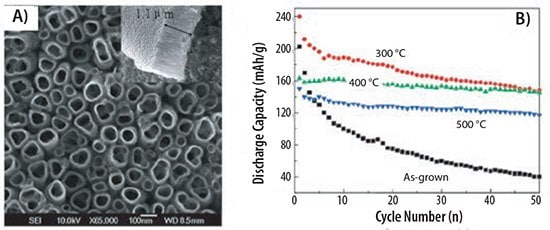
Figure 2.A) SEM image of a TiO2 nanotube array and B) the dependence of discharge capacity and cyclic stability on annealing temperature of the TiO2 nanotube array.6
Annealing Atmosphere Effect
In addition to the annealing temperature, the LIB performance of TiO2 nanotube arrays is also sensitive to the annealing atmosphere. Compared to annealing in N2 mentioned above, annealing the anodization-produced TiO2 nanotube array in CO results in improved battery capacity.
The comparison was carried out between two TiO2 nanotube array samples annealed in N2 and CO, respectively, at 400 °C for 3 hr. Figure 3 shows the charge/discharge properties and the cyclic stability of the samples annealed in N2 and in CO. It can be seen that the initial capacity of electrode film consisting of a TiO2 nanotube array annealed in CO is higher than the sample annealed in N2 (~223 mAh/g in CO vs. 164 mAh/g in N2). The cyclic stability of the sample annealed in CO is similar to that of the sample annealed in N2 and, as a result, the discharge capacity of the sample annealed in CO after 50 cycles is significantly higher than the sample annealed in N2. XPS analysis reveals that, due to the reduction capability of CO, the annealing in CO results in the Ti3+ state surface defect and Ti-carbon species in the TiO2. The presence of the Ti3+ surface defect and Ti-carbon species appears to enhance the electron transport of the TiO2 nanotubes and, thus, facilitates the electrochemical reaction with respect to the lithium-ion intercalation/deintercalation process. The impedance spectra show the sample annealed in CO possesses significantly lower resistance than that annealed in N2,7 which is consistent with the XPS analysis.
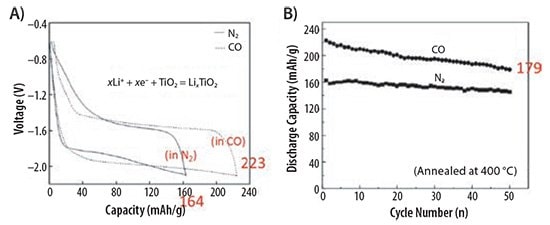
Figure 3.Enhanced LIB performance of TiO2 nanotube arrays annealed in CO. A) The first cycle charge/discharge properties and B) cyclic stability of TiO2 nanotube arrays annealed in N2 and CO.7
V2O5 Xerogel Films
V2O5 is a rather important material that has been extensively studied for LIB application due to its layered structure. V2O5 xerogel films easily can be produced from a V2O5 solution by dissolving V2O5 powder (Product. No. 204854) in an aqueous solution containing H2O2 and drop-casting the solution onto a substrate to form a wet film.9 The heat treatment of the wet film results in the formation of the V2O5 xerogel film. It has been also found that different atmospheres employed to heat-treat the V2O5 wet films may significantly influence the LIB performance. Figure 4 shows the difference in the V2O5 films annealed in air and in N2. It should be emphasized that both V2O5 films were prepared with the same precursor solution and procedure of drop-casting the V2O5 solution onto FTO glass substrates.10 Optical absorption spectra characterization revealed that, compared with the sample annealed in air, the film annealed in N2 presented a longer cut-off in wavelength, meaning a relatively narrower band gap of the latter (2.28 eV for annealed in N2 vs. 2.37 eV for annealed in air), as seen in Figure 4A. The yellow color of the air-annealed sample and the dark green color of the N2-annealed sample infers that the airannealed V2O5 film primarily contains V5+, while the N2-annealed sample contains some vanadium in lower valences, such as V4+ and V3+.
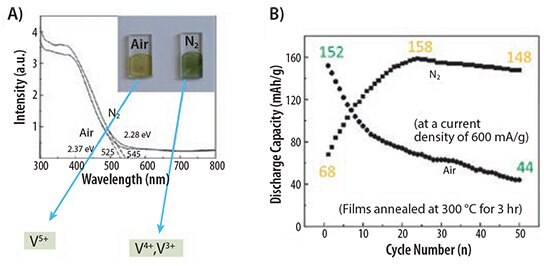
Figure 4.A comparison of the lithium-ion battery performance between V2O5 films annealed in air and in N2: A) optical absorption spectra and B) lithium-ion cyclic properties of V2O5 films annealed in air and N2.10
Figure 4B shows a comparison of the cyclic properties of the samples annealed in air and in N2 over the first 50 cycles. The sample annealed in air presents an initial discharge capacity of ~152 mAh/g but degraded very quickly to only 44 mAh/g at 50 cycles. In contrast, the sample annealed in N2 shows a low initial capacity of ~68 mAh/g; however, the capacity increased significantly during the first 24 cycles and reached 158 mAh/g. The capacity remained at a high level afterward, dropping a mere 10 mAh/g after 50 cycles, which indicates good cyclic stability of the N2-annealed sample.
It is believed that annealing the V2O5 film in N2 results in better performance than the film annealed in air due to the presence of low valence V ions, which induce impurity energy levels in the band gap of V2O5 and lead to the enhancement in capability for electron transport. This is the same as the case of TiO2 nanotubes annealed in CO mentioned previously. The films annealed in different atmospheres were also analyzed with electrochemical impedance spectra, which revealed the electrode resistance of the film annealed in N2 is about 30% lower than that of the film annealed in air.10
Besides annealing in N2, Mn doping has also been proven effective in creating low valence V ions in the V2O5 film, thereby enhancing LIB performance.11 The introduction of Mn in V2O5 is achieved by adding a soluble Mn salt (e.g., manganese acetate) into the aforementioned V2O5 solution during film preparation. Figure 5 shows the discharge capacities of both a pure V2O5 film and an Mn-doped V2O5 film over the first 50 cycles. Both films were annealed at 250 °C for 3 hr in air. The initial capacities, 138 mAh/g for the doped film and 145 mAh/g for the undoped film, are very close. However, the Mn-doped film presented much better cyclic stability compared to the undoped film. After 50 cycles the capacity of Mn-doped film remained 135 mAh/g; whereas it dropped to 86 mAh/g for the undoped film. The improved cyclic stability is due to Mn doping of the V2O5. XPS analysis revealed there are coexistent V5+ and V4+ in the Mn-doped V2O5, although it is not clear how the Mn dopant results in low valence V.
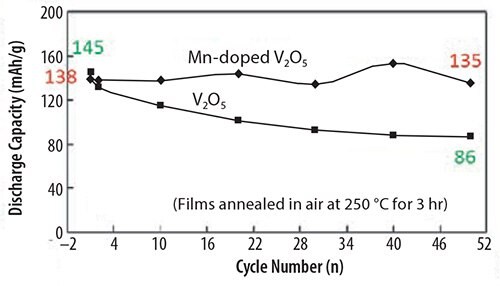
Figure 5.Enhanced cyclic stability of Mn-doped V2O5 film.11
Nanostructured V2O5
V2O5 Nanofibers
Electrospinning is a widely applied technique for the fabrication of one-dimensional (1D) nanostructures. An outstanding feature of 1D nanostructures developed for LIB is the resulting electrode films represent a good compromise between internal surface area and porosity. Electrode films comprised of 1D nanostructures possess both a large internal surface area (although it is usually smaller compared to that of nanoparticle films), suitable porous structure, and higher porosity than that of nanoparticle films. The high porosity is important as it allows the electrolyte to diffuse efficiently. Nanostructured V2O5 in the form of nanofibers is one example that demonstrates an electrode film with 1D nanostructures can outperform dense films or films comprised of nanoparticles.
V2O5 nanofibers can be prepared using electrospinning techniques by employing a V2O5 solution. In order to form the fiber structure, a polymer additive is often used to increase the viscosity of the V2O5 solution. Poly(vinylpyrrodidone) (PVP)
(Product. Nos. 234257, 856568, and 437190) is a readily available polymer proven to work for this purpose.12 The polymer additive is removed from the product by sintering the nanofiber powder at high temperatures (~500 °C) in air. Figure 6A shows SEM images of V2O5 nanofibers prepared with an electrospinning method. The image indicates the nanofibers are: (1) several tens of micrometers in length and ~350 nm in diameter after sintering; (2) comprised of interconnected V2O5 nanocrystals; and (3) the resultant film is well structured to provide large internal surface area and porosity. BET characterization revealed the surface area of the as-prepared V2O5 nanofibers to be 97 m2/g.
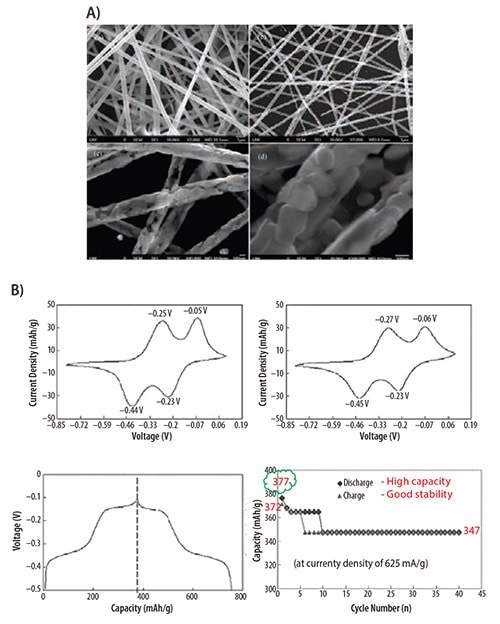
Figure 6.V2O5 nanofibers prepared with an electrospinning method for lithium-ion battery. A) SEM images of V2O5 nanofibers before and after being annealed (at 500 °C for 1 hr in air). B) Cyclic voltammetry curves and charge/discharge properties of the V2O5 nanofibers at a current density of 625 mA/g.12
LIB performance of the V2O5 nanofibers is shown in Figure 6B. Two anodic oxidation peaks located at –0.25 V and –0.05 V (vs. Ag/AgCl) corresponding to Li+ deintercalation, and two cathodic reduction peaks located at –0.44 V and –0.23 V corresponding to Li+ intercalation clearly can be seen on the cyclic voltammogram curves.12 All these redox peaks are well defined. The voltages of redox peaks show only a negligible shift even after 40 cycles. The current densities also change only slightly. From the cyclic test, it can be seen that after the 9th cycle the discharge capacity remains at a high capacity (~347 mAh/g), which implies excellent cyclic stability and reversibility of the V2O5 nanofiber electrode film. The superior performance of the V2O5 nanofiber electrode, which is significantly better than that of the aforementioned V2O5 xerogel films and other V2O5 nanostructures (such as V2O5 nanotube arrays, nanocable arrays, and nanorod arrays13,14), is believed to arise from the high internal surface area provided by the nanofibers and ideal porosity of the electrode film comprised of these nanofibers. The high porosity enables the lithium ion intercalation and deintercalation to take place efficiently.
Nanoporous V2O5 Films
The advantage of nanostructured materials for LIB are further demonstrated by employing V2O5 films prepared with the same V2O5 solution used for drop-casting described previously10,11 using a cathodic deposition method.15 The films were deposited onto FTO glass substrates under a voltage of –2.4 V. Such a voltage results in water electrolysis and generates H2 gas bubbles at the cathode, which is believed to cause the formation of nanosized pores in the films. The films were annealed at 500 °C to achieve desired crystallinity.
Figure 7A shows a typical SEM image of the as-prepared nanoporous V2O5 film. It reveals the film is comprised of nanosized crystallites of 20–30 nm diameter and contains pores on the order of 10 nm. While no other special structural feature is found on the film, interestingly, it delivered an extremely high initial capacity of ~402 mAh/g, and even after 200 cycles the capacity remained as high as 240 mAh/g (Figure 7B).15 Such capacities are more than twice as high as that of V2O5 xerogel films10 and, to some extent, are also higher than that of V2O5 nanofibers produced using electrospinning.12 The cathodic deposition method is very simple, low cost, reliable, and compatible with mass production. The film also demonstrated good capacity at high current densities. For example, it showed a capacity of ~120 mAh/g at 10.5 A/g (70 C) (Figure 7C). The high internal surface area of the V2O5 nanoporous films is believed to be the main reason for the superb LIB performance. However, in addition to high surface area, the presence of tetravalent vanadium ions (V4+) in the as-deposited film (before annealing) may also contribute to the high performance of V2O5 nanoporous films by catalyzing the growth of the V2O5 film during the electrochemical deposition process and enabling the formation of hierarchically structured electrode film with stacking flakes consisting of V2O5 nanoparticles.15
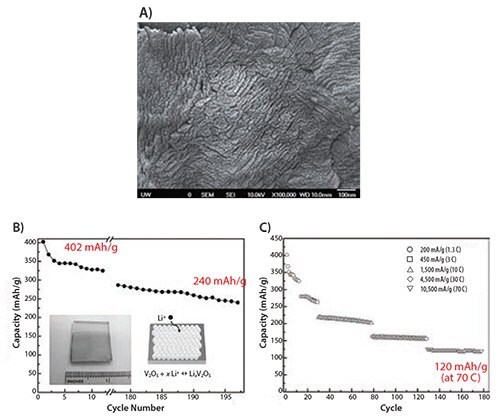
Figure 7.Nanoporous V2O5 film for lithium-ion battery application: A) SEM image of nanoporous V2O5 film; B) cyclic capacities at a current density of 200 mA/g (1.3 C); and C) cyclic capacities at different current densities up to 10.5 A/g (70 C).15
LiFePO4/C Nanocomposites
LiFePO4/C nanocomposites are another example demonstrating the optimization of post-treatment parameters is critically important to achieving high performance in LIBs. The fabrication of LiFePO4/C nanocomposites was carried out by: (1) adding l-ascorbic acid (C6H8O6) to a solution containing lithium hydroxide monohydrate (LiOH・H2O, Product. No. 254274), ferric nitrate Fe(NO3)3・9H2O (Product. No. 529303), and phosphoric acid (H3PO4; (2) refluxing the mixture at 60 °C for 1 hr to attain a solution of LiFePO4 (Product. No. 759546) with carbon; and (3) drop-casting and annealing the films in N2.16 l-ascorbic acid plays a role in this synthesis by reducing the iron ions from Fe3+ to Fe2+ and also serving as a source of carbon.
Figure 8 shows the SEM characterization of LiFePO4/C nanocomposite films annealed at different temperatures (500 °C, 600 °C, and 700 °C) and the XRD patterns of the films at increasing annealing temperature. The as-synthesized LiFePO4 were found to be amorphous and adopt an olivine phase with a crystallite size of ~20 nm when the temperature reached 600 °C. The crystallite size increased to ~30 nm at 800 °C. No peaks corresponding to carbon were seen in the XRD. This implies the carbon is amorphous and its presence does not bring any detectable influence on the crystal structure of LiFePO4. A careful EDX analysis revealed the carbon in the films takes the form of particles homogenously distributed on the surface of LiFePO4 crystallites.16
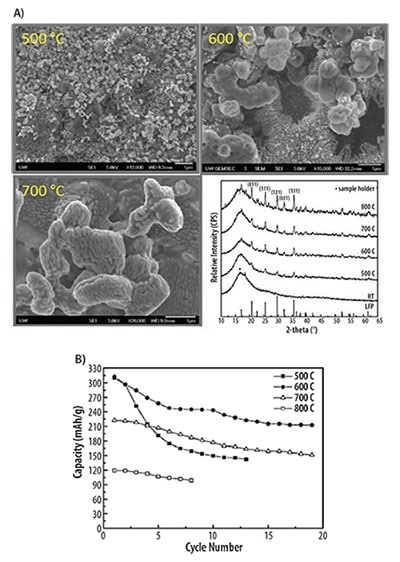
Figure 8. LiFePO4/C nanocomposite for lithium ion battery. A) SEM images and XRD patterns and B) cyclic discharge capacities of LiFePO4/C nanocomposite films annealed at different temperatures.16
Figure 8A shows a comparison of the cyclic discharge capacity of the LiFePO4/C nanocomposite films annealed at different temperatures. Despite the high initial capacity, the sample annealed at 500 °C presented poor cyclic stability. The capacity dropped rapidly and reached 139 mAh/g after 13 cycles. This is attributed to the insufficient crystallinity of the film annealed at 500 °C. The best performance was achieved for samples annealed at 600 °C, which demonstrated the highest capacities of ~312 mAh/g for the initial cycle and approximately constant capacity of 218 mAh/g after 20 cycles. Annealing at higher temperatures, 700 °C and 800 °C, resulted in a significant decrease in capacity (228 mAh/g and 120 mAh/g for the initial cycle, dropping to 148 mAh/g and 99 mAh/g after 20 cycles). It is believed that 600 °C is the optimal temperature for annealing the LiFePO4/C nanocomposite film because it gives rise to a slightly less crystallized/less compact structure that can accommodate more lithium ions and facilitate diffusion within the film.16 Although films annealed at higher temperatures (e.g., 700 °C and 800 °C) possessed better crystallinity, their compact structure and decreased internal surface area delivered capacities lower than that of film annealed at 600 °C. This is also consistent with the trend observed with TiO2 nanotube arrays produced with an anodization method discussed earlier.6
Conclusions and Remarks
Based on the above discussions, we can conclude that the capacity and cyclic stability of LIB technology rely heavily on the composition, morphology, crystal structure, and defects of the materials that form the electrode films. These parameters intrinsically affect the faradaic reaction occurring at solid–liquid interfaces and the electron/ion transport within batteries, and they are dependent on method of synthesis and post-treatment.
Internal Surface Area
Based on the results on MnO2 nanowall arrays, TiO2 nanotube arrays, V2O5 nanofibers, and V2O5 nanoporous films, it can be clearly seen that the morphology of materials, which primarily depends on the method of synthesis, plays a key role in determining the internal surface area. High surface area is usually the primary determinant of a material’s performance in LIBs, as it allows for a large solid–liquid interface between the electrode films and electrolyte, enabling an efficient faradaic reaction. In addition to the synthesis method, which primarily determines the material’s morphology, post-treatment such as annealing temperature and atmosphere also present an effective way to tailor the material’s morphology. High internal surface area and the appropriate porosity benefit LIB performance by allowing the lithium ions to diffuse and to intercalate/deintercalate efficiently, contributing to high capacity.
Pathways for Electron and Ion Transport
The morphology of the materials used in batteries also influences the pathways of transport of electrons and lithium ions. In this aspect, 1D nanostructures present an obvious advantage over nanoparticles due to a significant reduction in the number of grain boundaries encountered during the electron or ion transport within electrode films. This makes the redox reaction in relation to lithium-ion intercalation and deintercalation more efficient, which allows batteries to be made with higher capacity. However, for electrode films with 1D nanomaterials, one usually needs to balance the trade-off between direct pathways for highly efficient transport and lower internal surface area provided by the 1D nanomaterials.
Crystallinity
Crystal structure or crystallinity is another issue closely related to the synthesis method and post-treatment. The use of amorphous materials for LIBs still seems to be up for debate. The MnO2 nanowall arrays and TiO2 nanotube arrays discussed above suggest amorphous materials may offer higher capacities compared to crystalline materials. This is because the relatively open structure of amorphous materials accommodates more lithium ions. However, as shown in the case of a TiO2 nanotube, cyclic stability may be very poor for amorphous materials without heat treatment. It is generally observed that materials with better crystallinity possess better cyclic stability; whereas, higher capacity is achieved in less well-crystallized materials. For example, for the LiFePO4/C nanocomposites discussed above, the sample annealed at 600 °C demonstrated higher capacity than those annealed at 700 °C and 800 °C. In general, the crystallinity of a material is related to its electric conductivity. A less well crystallized material may contain some defects, such as oxygen vacancies, which lead to formation of an impurity energy level in the band gap and, therefore, lead to better conductivity than those perfectly crystallized materials. This enables higher capacity in a battery. It is worth pointing out that heat treatment at elevated temperatures not only reduces conductivity, it also causes the morphology to change. This usually corresponds to an increase in the size of crystallites and is a negative factor that diminishes the battery capacity due to a decrease in the internal surface area of the electrode film.
Defects
As mentioned above, the electric conductivity of the electrode film is related to its crystallinity via defect-induced impurity energy levels. The degree of defects formed in a material is affected by both the annealing temperature and the annealing atmosphere. It is shown that the use of CO and N2 atmospheres during annealing of TiO2 nanotubes and V2O5 xerogel films, respectively, introduces desired defects that result in the formation of low valence ions (e.g., Ti3+, and V4+, V3+) and enhance the conductivity of electrode that leads to improvement in the battery capacity. The example of Mn-doped V2O5 film shows that in addition to controlling the annealing atmosphere, the use of a dopant during the material synthesis is also a way to introduce low valence ions and improve the battery performance.
Related Products
References
To continue reading please sign in or create an account.
Don't Have An Account?